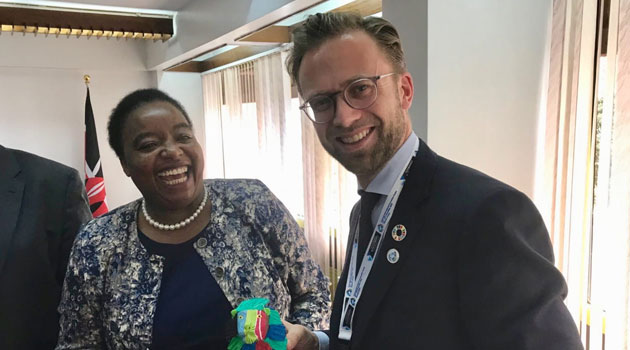
In yet another commitment, Antigua and Barbuda, a Commonwealth State comprising of twin namesake isles committed to banning plastic utensils and polystyrene next year/CFM NEWS
NAIROBI, Kenya, Nov 29 – Global efforts to combat the proliferation of marine litter received a major boost during the just concluded Sustainable Blue Economy Conference after Norway and the World Bank committed US$ 300 million towards combating sea waste.
Out of the US$300 million, the Word Bank and Norway earmarked US$100 million to manage dumping in oceans.
To further entrench the fight against marine waste, the Norway delegation led by Nikolai Astrup, Minister of International Development, pledged US$ 200 million for the next four years in support of initiatives aimed at addressing the increase of microplastics in oceans.
In yet another commitment, Antigua and Barbuda, a Commonwealth State comprising of twin namesake isles committed to banning plastic utensils and polystyrene next year.
Bahamas, a country in the Caribbean, pledged a ban on single-use plastic bags, straws, and cans by 2020.
Other pledges included the implementation of a zero plastic pollution campaign by Timor Leste, a Southeast Asian country, and sustainable plastic free tourism by the autonomous region of Sao Tome and Principe, an African island close to the equator.
Java House, a chain of coffee houses, undertook to a transition to plastic free services in all its outlets.
A total of eight commitments on plastic waste management were made at the three-day conference that ended Wednesday, where over 62 undertakings were made in the broad areas on marine protection, plastics and waste management, marine safety and security, and financing.
Kenya committed to confront the challenge of waste management and plastic pollution through stringent regulations having banned the use of disposable plastic in August last year after a six-month notice gazzeted in February 2017 lapsed.
The use of plastic bags and containers has emerged in the recent days as a huge existential threat to the fishing industry with latest estimates by United Nations Environment Programme showing in excess eight million metric tons of plastic are thrown into the ocean each year.
The projections also put the amount of micro-plastics – nylon, polystyrene, and polyethylene – being dumped into the ocean annually at 230,000 metric tons annually, an average of 13,000 pieces of plastic per square kilometre of ocean, further endangering fish.
The amount of plastic waste in the ocean in projected to increase tenfold by 2020 superseding outnumbering fish by 2050.
Plastic microparticles have the ability of being absorbed into the flesh of fish making seafood unsafe for human consumption.
The plastic microparticles are particularly harmful as some of them may have heavy metals embedded.
In July 2017, leading scientists in France and Malaysia projected the annual consumption of microplastics through seafood in Europe at 11,000.
In the report published in Scientific Reports, a scientific journal by an international scientific publisher Nature Research, the scientists reported thirty-six microplastics in 120 assorted fish samples.
Although Kenya has joined other countries in sea-cleaning campaigns in previous years, the country is yet to set a target for the realization of a pollution free seacoast.
Leading the global efforts towards actualization of Sustainable Development Goal 14 on sustainable management and protection of marine and coastal ecosystems from pollution, Sri Lanka in January declared an ambitious goal to attain a pollution-free seacoast by 2030.
The Asian country has stepped up waste recycling in part of a bold action plan to turn the tide on plastics.
According to the United Nations, over three billion people depend on marine and coastal resources for their livelihoods.
Other than plastic pollution, this vital resource faces other dangers including over-exploitation of at least 30 per cent of world’s fish stock.
The global agency has also reported a 26 per cent rise in ocean acidification since the industrial revolution.








































